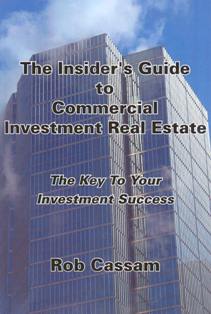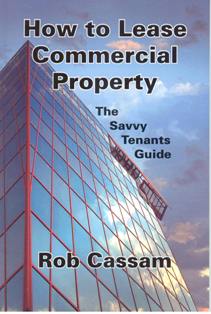For those of you keeping
track, please note I have changed my email address to
robcassam@gmail.com.
Please update your records.
In this issue I focus on a variety
of important commercial real estate topics for both tenants and owners. I hope some of these may
help you know or in the future. This new format includes money making tips
for all types of commercial real estate including tips for end users of
commercial real estate.
|
|
Keep Your Tenants - Easier Than Finding New Ones
|
A property manager may spend
quite a large amount of
money advertising to fill
vacancies in a building.
Once the tenants are in,
everything within reason is
done to keep them happy and
paying the rent. It is
difficult when one of these
tenants is enticed to move
to another location.
Leases can stretch the
length of time a tenant will
stay with you. Six-month,
nine-month and one-year
leases are common in
apartments, much longer in
commercial buildings.
The Anti-Raid
Clause In A Commercial Lease
An
anti-raid clause in a
commercial lease can make a
tenant think twice about
vacating the space occupied
in a building to move to
another building. When such
a clause is in the lease,
the landlord can treat the
move of the tenant as a
breach of the contract and
cause all of the rent due
under the lease to become
immediately due and payable.
The landlord may want
this clause and any lease
where the presence of that
tenant in the building is
deemed to be important to
the success of the building.
If the building is devoted
to a certain type of
business and the tenant is a
leader in the field, the
landlord might expect raids
from rival building owners
who might also have
buildings devoted to that
kind of tenants. The
anti-raid clause gives the
landlord the right to an
injunction prohibiting the
tenant from moving from the
leased space. However, there
is no record of a court ever
having enforced such a
provision. Any
building owner is entitled
to run his business in his
own self-interest.
Therefore, another building
owner whose tenant is being
'raided' cannot recover
damages against the raiding
building owner for inducing
a breach of lease. This rule
can change if the raiding
owner makes false claims
such as that the tenant's
present quarters are located
in a building that is in
dangerous condition or is
slated for condemnation or
demolition.
What Makes Apartment Tenants
HappyWhen
landlords, architects and
builders design apartments,
none of them have lived in
an apartment for years. They
assume they know what
tenants want.
Apartment living is a
lifestyle decision for many
tenants. One landlord,
together with his management
company polled tenants in a
survey. They were surprised
by the results. They
found that apartment tenants
would rather have more car
wash areas, longer pool
hours, and a bigger club or
recreation room on the
premises instead of lower
rent. The survey found that
tenants preferred that the
landlord provide more and
better amenities rather than
making any changes in the
rental arrangements.
What They Really Want
Before the survey the
landlord and management firm
expected to see that tenants
would be concerned with rent
levels, money rather than
amenities. Rent levels were
well down on the list.
In addition to the three
most frequently mentioned
amenities (car wash, pool
hours, and rec room)--which
the manager noted are the
easiest for a landlord to
give tenants--tenants also
said they would appreciate
having designated parking
spaces, a barbecue or picnic
area, tenant gardening, and
permission to hold yard
sales.
|
Single Tenant Properties - Not For All Investors
|
Around 25% to 35% of the value of commercial
properties are single-tenant properties (STPs). This large percentage means
that institutional investors such as pension funds, as well as smaller
investment groups must consider this type of investment. There are many uses
ranging from office to industrial to retail. They can include office
buildings, warehouses, department stores, supermarkets and other retail use.
There are advantages and disadvantages in this type of ownership compared to
multi-tenant properties.
Types of STPs
1) Corporate
sale-leasebacks. Most of the STP properties are corporate properties that
have been sold to third parties and simultaneously leased back by the
corporate seller, often for a long term. The usual reason for the seller was
to raise additional cash.
2) Build to Suite- Build to suit (BTS) generally refers to office,
industrial, or warehouse facilities constructed for a single user and
designed specifically for its particular needs. In an over-supplied market,
BTS eliminates the rent-up risk for developers. The completed building is
either held by the developer or is sold to a third party who simultaneously
enters into a long-term lease with the user.
3) Existing STPs. The third form includes
multi-tenant buildings that ultimately are occupied by a single tenant that
expands space plus the two preceding types that are leased to third parties
after the original user vacates. Since all in this group are "second
generation" tenants, buildings in this category are often older than other
STPs.
Convertibility To Other Use
The major consideration to an investor is whether the
building can be converted to related uses at a low cost. This rules out
special use properties such as refineries or manufacturing facilities. It
may also rule out some corporate headquarters or institutional office
buildings, constructed to meet business objectives of the original user.
Often these were built without regard to capital outlays or ease of
maintenance.
Warehouse and distribution facilities might be easily subdivided provided
that the original design did not include a central access. They can be
obsolete quickly if transportation patterns change.
Retail properties may require
considerable alteration to create suitable individual stores. Service and
customer access must be available for each unit. Parking may not be adequate
with a larger number of tenants.
Advantages Of STPs
The major advantage of the STP is
the absence of any short-term re-leasing risk plus a known cash flow for the
term of a long lease. Another consideration is the minimal management
requirement on the investor since the properties are usually leased under
net leases.
Risks Of STPs
The obvious risk is when a tenant does not renew the
lease or the business fails. The vacancy rate immediately jumps to 100%.
Time to find a new tenant or to renovate the property can be very costly.
>A STP may not be any
riskier than a multi-tenant building, providing the lease is long and the
tenant is a high quality company. Risks can be minimized by requiring
tenants to have high credit ratings and by providing in the lease that
rental payments must continue under all circumstances except possible
destruction or condemnation of the building (in which case, insurance
proceeds or the condemnation award should reimburse the owner's capital
investment.)
>A STP that
fits all of the qualifications for a good investment can be worthwhile
acquisition for the institutional or individual investor.
|
|
Property Turn-Arounds For Profit
|
In any market, good or bad, there are always
problem properties (to someone). Most are only troubled or problem
properties because of the current ownership. Some may be neglected only
because the present owner has failed to do fairly simple things that can
solve the problems. Buying property and solving problems is a profit-making
business.
The number one requirement is location, as it always
is in real estate. Even if you spend a great deal of money refurbishing a
structure in a questionable location, it will always be in that bad
location. The successful turn-around property is a property that can be
improved to attract more tenants at higher rents, a building that can be
changed to another use, or a building that can be torn down and successfully
rebuilt to a better use.
Here are some of the signs on the property that will
lead the an investor to further investigation:
>Run down (uncared for)
landscaping.
>Partially vacant rentals.
>Collection
problems of rents.
>Rental units in poor condition.
>Obvious
mismanagement of property.
How to follow up on such a find. (We presume the
property is on the market.)
Start with the neighborhood. Check rent levels in
buildings like the target property (in condition like it will be after a
makeover). Make a list of the needed repairs that your property will need
and get bids. Add a generous percentage to the resulting figures since bids
are usually low.
Interview current tenants. See if any will stay,
particularly if the property is improved. Check the existing rental
agreements or leases. Make sure that current tenants are paying amounts in
the agreements.
Plan to create amenities that make the property a
better place to live or work.
Older apartment units, the usual target for a
turn-around, need to be upgraded to stay competitive. Modernize, installing
dishwashers, microwave ovens, disposals, and new and more electrical
service. Today's tenants have so many electrically powered gadgets, i.e.
computers, TV's, hair dryers etc. that even in small units you should
consider supplying 100 amps of power and in larger units 200 amps.
What Are The
Risks?
Knowledgeable property developers and managers (especially those familiar
with empty or near-empty office, hotel, and apartment buildings) caution
that buying troubled property requires taking a risk.
The profits
can come from any one or a combination of circumstances.
>A market turnaround caused by a
boom in the local and/or national economy.
>An improved system for promoting
and operating the property. Some syndicates are being formed solely to
manage the troubled property with an option to buy when and if it hits a
specified profit level.
>Purchase of the property at a bargain price, often
combined with imaginative and untraditional financing techniques. Some
lenders are asked to share the financial risks by accepting a low initial
interest rate in return for a big share of the profits later on. Sometimes
the seller of the troubled property is asked to retain a financial stake in
the property and to help turn it around. The seller's experience and
involvement in the project from the start can be valuable.
>Including
the troubled property in a larger development plan. An office building that
sits empty might become part of a new industrial park with hotels,
conference facilities, and residential apartments, all of which are
successful.
Take another look at troubled properties in your area.
With fresh new ideas and a re-structuring of the mortgages, the troubles may
go away, leaving a profitable investment for you.
What is the
upside in a turn-around project? It is in the form of increased rents, lower
vacancy rates, happier tenants, and a project you can sell easily because
most buyers of investment property want to have "Pride of Ownership"
investments. |
|
|
|
In This Issue
|
|
Keeping Your Tenants- Easier Than Finding New Ones |
|
Single Tenant Properties- Not For All Investors |
|
Property Turn Arounds For Profits |
|
Featured Listings |
|

|
Latest Charlotte Area Market Fundamentals
REIS provides the latest overall market fundamentals for
office, industrual, and apartments. Enjoy reading a wealth of information in
order to understand the latest trends.
click here
|
|
Contact Information |
Rob Cassam, MBA, CCIM
Carolina Realty Advisors
1001 East Blvd. Ste. B
Charlotte NC 28203
Tel: (800) 587-4066 Ext. 100
Fax: (704) 442-8841
robcassam@gmail.com
Website
|
|
Services... |
|
I provide real estate brokerage services for small and medium sized businesses,
investors, and individuals who are fed up with losing money, paying too much
and/or, spending too much time not getting the right piece of property for their
particular situation. I act as the quarterback in the real estate transaction for my clients who coach
me in managing all of their different needs.
My clients love not needing to worry about making bad decisions or bad
investments and love winning negotiations.
Owners Of Commercial Space
How
are your properties helping you in your life?
Have
your investments turned out as planned?
What
types of problems have you had growing your portfolio?
How
has the economy impacted your rents and vacancy?
Are
you satisfied with your income and asset portfolio?
Is it meeting your needs?
How
much of a problem is dead equity in your property?
How
long are you prepared to go on doing nothing about situations in your business
that are not quite right?
End Users Of Commercial Space
What types of growing pains is your company facing with your location?
Are rising occupancy costs a challenge your company is facing?
Is having too much space or not enough space a challenge your company is
facing?
How much of a problem is dead equity in your property for you?
How long are you prepared to go on doing nothing about situations in
your business that are not quite right?
Give me a call, I may be able to help.


|

How To Lease Commercial Property |
|